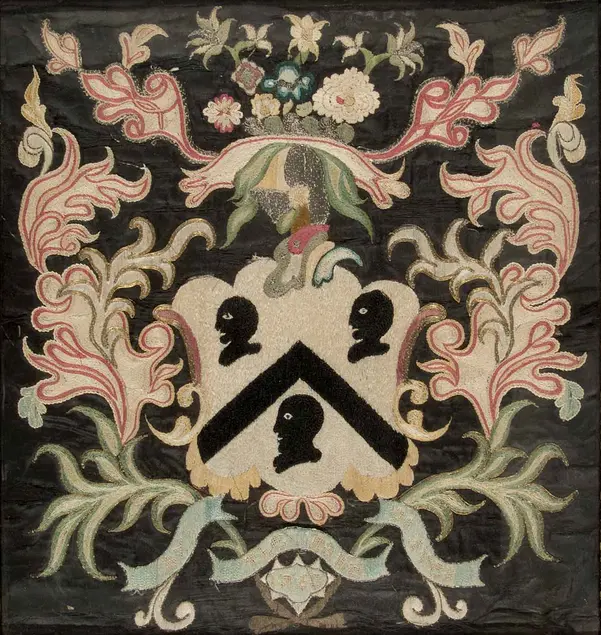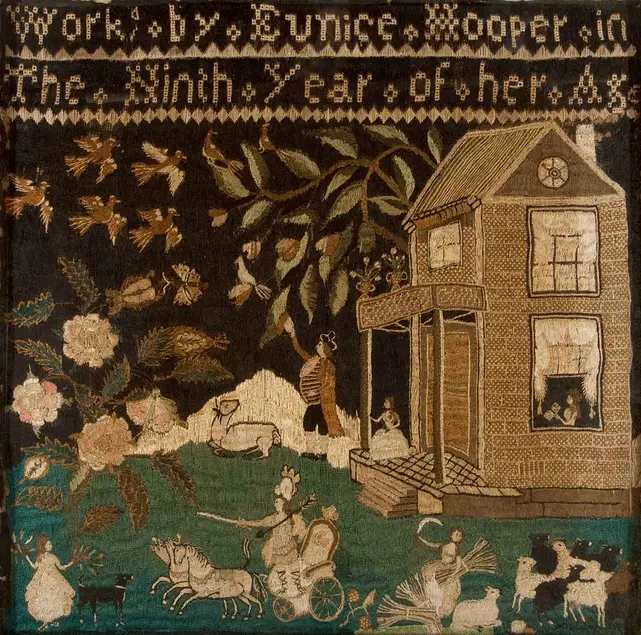Useful Hours: Needlework and Painted Textiles from Southern California Collections

Rebecca Ives Gilman (1746–1823), Ives Family Coat of Arms, 1763. Silk, gold and silver thread on black silk, 17 × 16 in. Huntington Library, Art Collections, and Botanical Gardens, promised gift of Thomas H. Oxford and Victor Gail.

Eunice Hooper (1781–1866), Sampler, ca. 1790. Silk on linen, 21 × 21 ¼ in. Collection of Jonathan and Karin Fielding, Los Angeles.


Rare examples of early American needlework offer new insight into the lives and skills of the young women who made them
Taking its title from a verse stitched in a 1796 sampler by 10-year old Anne "Nancy" Moulton, “Useful Hours” explores the development of needlework and painted textiles in the United States in the late 18th and early 19th centuries through a selection of more than 20 samplers, coats of arms, family trees, mourning pictures, pocketbooks, and narrative painted textiles made primarily by young women in their early teenage years as a preparation for marriage and later life. The exhibition, which includes several exceedingly rare examples of 18th-century American needlework, is drawn in large part from the collection of Victor Gail and Thomas H. Oxford, a promised gift to The Huntington. To provide these surprisingly beautiful, touching, and finely wrought examples with an appropriate historical context, they are juxtaposed with several examples of British needlework, a related painting, American furniture, and other decorative arts objects, along with books and manuscripts from the Huntington’s collections.
Related Programs
Curator tour
June 12 (Wednesday) 4:30 p.m.
Join curator Hal Nelson for a private tour of the exhibition, featuring embroidered samplers and other works—many of them created by young girls—from the 18th and 19th centuries. Members: $15. Non-members: $20. Registration: 626-405-2128.
Taste of Art: The Family Tree
June 22 (Saturday) 9 a.m.–12:30 p.m.
Explore the early American domestic arts of needlework and cookery with Maite Gomez-Réjon from ArtBites. After a tour of the exhibition, participants will prepare a meal from the classic 1824 cookbook The Virginia House-Wife, which was a popular wedding gift for 19th-century brides. Members: $85. Non–members: $95. Registration: 626-405-2128.
Embroidery Workshop
July 27 (Saturday) 9 a.m.–4 p.m.
In the 18th and early 19th centuries most girls learned cross-stitch at a very young age and produced samplers that were often hung with great pride in the family home. At the turn of the 20th century, a new form of conventionalized design was developed and became prevalent in surface embroidery. Join Ann Chaves of Inglenook Needlework Studio and create a small table runner, with a botanical motif, based on an Arts and Crafts style design. The runner will be embroidered with purl cotton thread on fine Belgian linen. All supplies included in the class fee. Members: $140. Non-members: $155. Registration: 626-405-2128.
Lecture - Thirsting for Knowledge: Women’s Education in the Early Republic
Aug. 14 (Wednesday) 7:30 p.m.
The exhibition "Useful Hours: Needlework and Painted Textiles from Southern California Collections" holds examples of beautiful samplers and pictorial embroidery from the early 19th century. Does this needlework represent the extent of women's education during the period? Margaret A. Nash, associate professor and graduate advisor for continuing students at U.C. Riverside's Graduate School of Education, discusses educational possibilities open to women in the early American Republic, and the social and cultural factors that shaped women's aspirations, including Enlightenment beliefs, religious expectations, opportunities for employment, and a desire for education. Free; no reservations required. Ahmanson Room, Botanical Center.